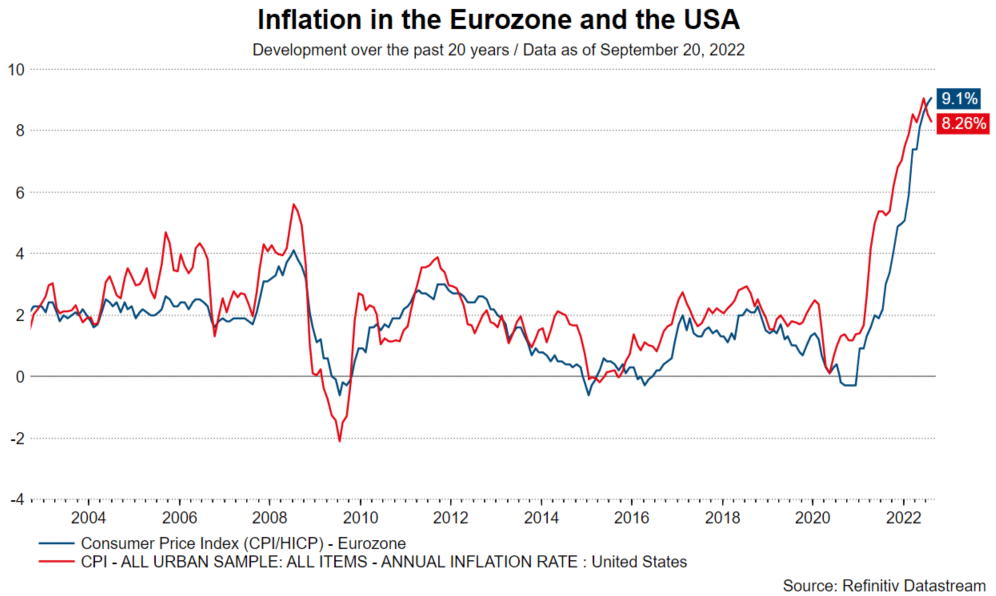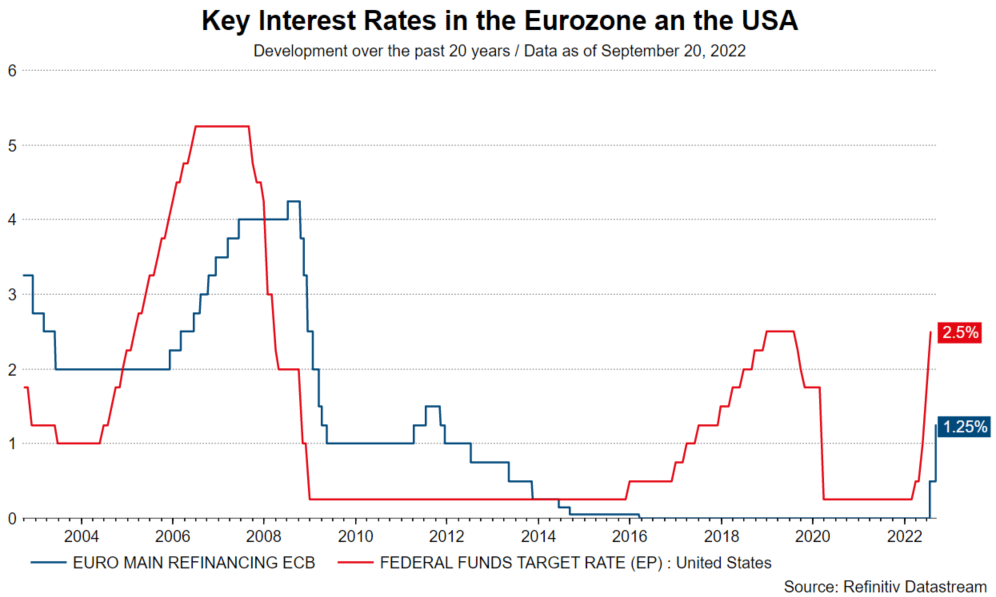The main driving factor for markets since the beginning of the year has been the sharp increase in key rate hike expectations for advanced economies as inflation has remained unexpectedly high. This is putting downward pressure on asset prices in two ways. First, the higher the discount rate, the more the present value falls. Second, the rapid and synchronous key rate hikes by central banks pose downside risks (recession) for the global economy.
Falling inflation outside Europe
At least at a global level, there are signs of a fall in inflation in the second half of the year compared with the first six months. In the USA, consumer price inflation rose only slightly in July (0% month-on-month) and August (0.1% month-on-month). The main reason for this is the fall in energy prices. In Europe, however, this trend is not discernible. In the euro zone, consumer price inflation climbed by 0.6% month-on-month in August to 9.1% year-on-year.

Core inflation too high
However, looking at headline inflation masks a key, troubling development. Even in the countries with declining inflation, pass-through effects from the original inflation drivers (energy, goods prices) to numerous other price components have set in. In the USA, consumer price inflation excluding food and energy (core rate) rose much more strongly than expected in August (by 0.6% month-on-month to 6.3% year-on-year). In the UK, core inflation rose by 0.8% p.m. to 6.3% p.a. and in Sweden by 0.6% p.m. to 6.8% p.a.
Increasing expectations for key rate hikes
In line with this, expectations for quick rate hikes have increased in numerous countries over the past week. The priced-in Fed funds rate for March 2023 has risen to 4.4% from 4.0% on Monday. There is a growing realization that the monetary policy stance has been far too expansionary and that restrictive interest rates are needed to contain underlying inflationary pressures. However, there is considerable uncertainty about the dynamics of inflation. Underlying inflation, and hence the real interest rate, cannot be estimated with satisfactory accuracy. As a result, central banks also have little idea about the interest rate level at which monetary policy actually starts to have a restrictive effect.
Fed key rate hike by 75 basis points
In the coming days, at least one central bank is expected to raise its key interest rate by 0.75 percentage points. For the U.S. central bank, the increase from 2.5% to 3.25% is already reflected by market prices. But the central banks in the United Kingdom (Bank of England) and Sweden could also raise the key interest rate substantially (BoE: from 1.75% to 2.5%, Riksbank: from 0.75% to 1.50%). The European Central Bank (ECB) also made a significant interest rate hike of 75 basis points at its last meeting.

Falling economic indicators
In addition to persistently high inflation, high-frequency survey-based economic indicators point to a slowdown in global real economic growth. Next Friday, the Purchasing Managers’ Index (PMI) flash estimates for the month of September will be released for major countries in the developed economies. In August, the manufacturing PMI pointed to a recession in the manufacturing sector. Even if the overall PMI were to rise in September, the interpretation would likely not be favorable. After all, if a recession does not materialize immediately, the scope or even the need for central banks to raise key interest rates even more increases.
Glimmers of hope
Of course, there are also glimmers of hope. In the USA, the University of Michigan’s preliminary consumer sentiment report for September showed inflation expectations falling further. One-year inflation expectations are now well off the March high (4,6% vs. 5.4%). At 2.8%, long-term inflation expectations are also below the recent high (3.1% in June). The Fed will also have noticed this development. Market speculation for an interest rate hike by a full percentage point next Wednesday is exaggerated.
For a glossary of technical terms, please visit this link: Fund Glossary | Erste Asset Management
Legal note:
Prognoses are no reliable indicator for future performance.
Legal disclaimer
This document is an advertisement. Unless indicated otherwise, source: Erste Asset Management GmbH. The language of communication of the sales offices is German and the languages of communication of the Management Company also include English.
The prospectus for UCITS funds (including any amendments) is prepared and published in accordance with the provisions of the InvFG 2011 as amended. Information for Investors pursuant to § 21 AIFMG is prepared for the alternative investment funds (AIF) administered by Erste Asset Management GmbH pursuant to the provisions of the AIFMG in conjunction with the InvFG 2011.
The currently valid versions of the prospectus, the Information for Investors pursuant to § 21 AIFMG, and the key information document can be found on the website www.erste-am.com under “Mandatory publications” and can be obtained free of charge by interested investors at the offices of the Management Company and at the offices of the depositary bank. The exact date of the most recent publication of the prospectus, the languages in which the fund prospectus or the Information for Investors pursuant to Art 21 AIFMG and the key information document are available, and any other locations where the documents can be obtained are indicated on the website www.erste-am.com. A summary of the investor rights is available in German and English on the website www.erste-am.com/investor-rights and can also be obtained from the Management Company.
The Management Company can decide to suspend the provisions it has taken for the sale of unit certificates in other countries in accordance with the regulatory requirements.
Note: You are about to purchase a product that may be difficult to understand. We recommend that you read the indicated fund documents before making an investment decision. In addition to the locations listed above, you can obtain these documents free of charge at the offices of the referring Sparkassen bank and the offices of Erste Bank der oesterreichischen Sparkassen AG. You can also access these documents electronically at www.erste-am.com.
Our analyses and conclusions are general in nature and do not take into account the individual characteristics of our investors in terms of earnings, taxation, experience and knowledge, investment objective, financial position, capacity for loss, and risk tolerance. Past performance is not a reliable indicator of the future performance of a fund.
Please note: Investments in securities entail risks in addition to the opportunities presented here. The value of units and their earnings can rise and fall. Changes in exchange rates can also have a positive or negative effect on the value of an investment. For this reason, you may receive less than your originally invested amount when you redeem your units. Persons who are interested in purchasing units in investment funds are advised to read the current fund prospectus(es) and the Information for Investors pursuant to § 21 AIFMG, especially the risk notices they contain, before making an investment decision. If the fund currency is different than the investor’s home currency, changes in the relevant exchange rate can positively or negatively influence the value of the investment and the amount of the costs associated with the fund in the home currency.
We are not permitted to directly or indirectly offer, sell, transfer, or deliver this financial product to natural or legal persons whose place of residence or domicile is located in a country where this is legally prohibited. In this case, we may not provide any product information, either.
Please consult the corresponding information in the fund prospectus and the Information for Investors pursuant to § 21 AIFMG for restrictions on the sale of the fund to American or Russian citizens.
It is expressly noted that this communication does not provide any investment recommendations, but only expresses our current market assessment. Thus, this communication is not a substitute for investment advice.
This document does not represent a sales activity of the Management Company and therefore may not be construed as an offer for the purchase or sale of financial or investment instruments.
Erste Asset Management GmbH is affiliated with the Erste Bank and austrian Sparkassen banks.
Please also read the “Information about us and our securities services” published by your bank.
